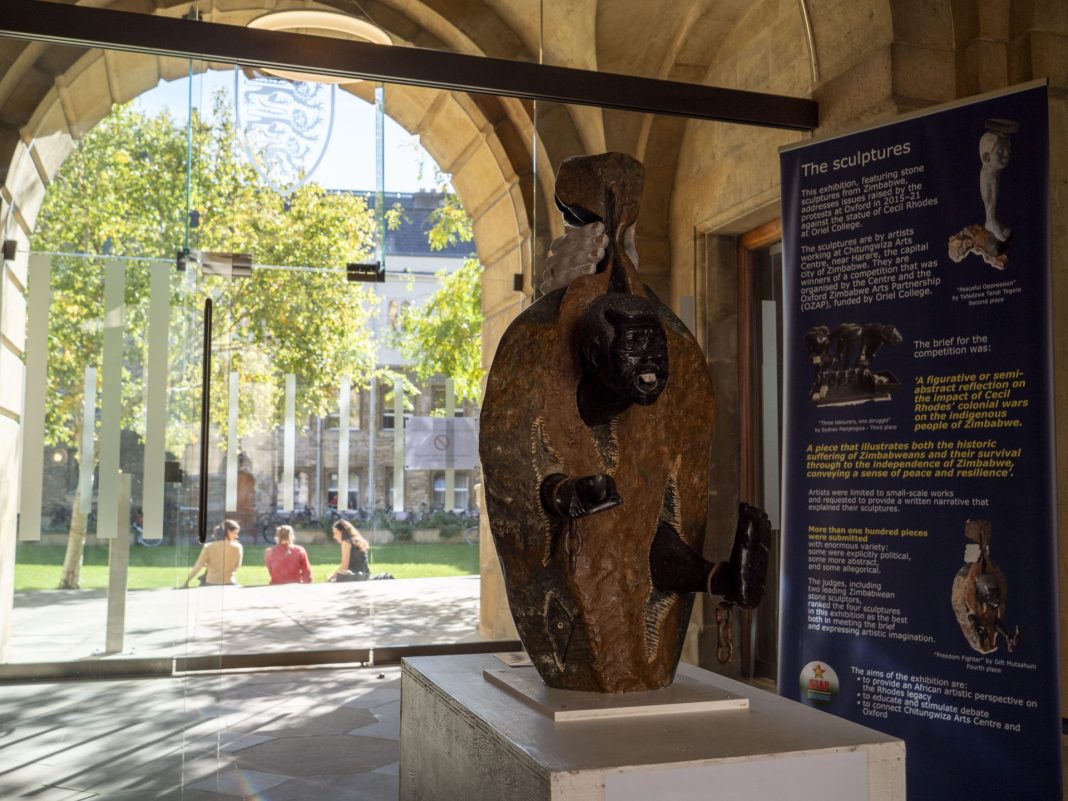An art exhibition designed to contextualise the legacy of Cecil Rhodes was unveiled at Oriel College on 3rd October. The exhibition features sculptures from Zimbabwean artists which were selected as part of a competition organised by the Oxford Zimbabwe Arts Partnership (OZAP).
An Oriel spokesperson told Cherwell that the exhibit aims to “deal with our association with Cecil Rhodes, add new layers of meaning to his statue and build a closer relationship with southern Africa”.
The judging panel for the competition included: Norbert Shamuyarira, a prominent sculptor; Be Manzini, a UK-based Zimbabwean artist; Elleke Boehmer, trustee of the Rhodes Trust; and Oriel’s Provost Lord Mendoza. The competition’s winning piece by Chitungwiza-based artist Wallace Mkankha, titled ‘Blindfolded Justice’, is the centrepiece of the exhibit.
The exhibit offers an artistic perspective on Rhodes’ impact on the people of Zimbabwe whilst tracing the history of the ‘Rhodes Must Fall’ movement, a campaign which began in Cape Town in 2015, eventually moving to Oxford. The movement’s objectives were established in 2020 during the Black Lives Matter movement. They include diversifying the curriculum as well as the removal of the Cecil Rhodes statue at Oriel.
Removing Rhodes’ statue has been a contentious issue for both the Oriel JCR and the College’s Governing Body. Despite the Governing Body voting to remove the statue in June 2020, the College abandoned the plans in 2021 due to “considerable challenges at the planning stage” of taking down part of a Grade II-listed monument.
The College’s spokesperson told Cherwell: “The College has worked to expand its academic coverage of Africa, race and colonialism, to increase support for academics from Africa, including through the provision of graduate scholarships, and to collaborate on outreach programmes for young people from Black and minority ethnic backgrounds.”
Oriel’s JCR President said that “neither students nor the JCR committee have exclusive influence on the statue or related decisions”, adding that the exhibition is “a small step in the right direction towards achieving a more accurate portrayal of the history and current state of the College, though it is far from exhaustive in addressing the legacy of historical injustices”.
The JCR President emphasised that the JCR is “overwhelmingly welcoming to all students” and “is committed to creating an inclusive community for all students”.
Rhodes studied at Oriel intermittently from 1873 to 1891, soon after which he entered politics, where he became prime minister of the Cape Colony, a territory of modern-day South Africa. From 1890, he (along with the British South Africa Company) colonised Zimbabwe, with his actions leading to the deaths of over 20,000 people.
After his death in 1902, he left £100,000 to Oriel College and £3 million to Oxford University. The latter donation was used to establish the Rhodes Trust, which provides scholarships for people from the United States, Germany, and the former British Empire. Former Rhodes Trust scholars include US politicians Cory Booker and Pete Buttigieg, journalist Ronan Farrow, and astronomer Edwin Hubble.
The exhibition was open daily until 8th October, after which it was moved to the University Church of St Mary the Virgin where it will remain until December.


